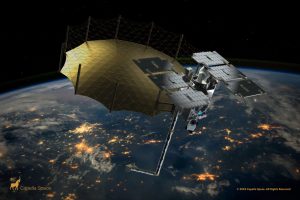Specifically, it is the Docking and Fluid Transfer (DFT) port. This is for its SatDrive propulsion systems, to enable in-space refueling for its customers.
Note that the DFT port is only first scheduled to launch in 2025. However, the company said multiple SatDrive customers are in line to use the DFT port system.
“With low mass, low risk, and zero cost, we believe it’s getting close to a ‘no brainer’ decision for any Dawn customer who sees value in refueling,” said Dawn Aerospace CEO, Stefan Powell. “This allows customers to make the leap of faith, even though there are no established refueling services yet.”
DFT port
The DFT port will replace currently standard manual fill/drain valves used for propellant loading on the ground. Instead there will be a passive interface that can facilitate refueling in space. The weight cost for this will 0.6 kg, says Dawn.
The port design includes provision for two pressurized propellants, nitrous oxide, and propene or ethane, as well as power and data connections.
It will be provided as standard for all its SatDrive customers with propulsion systems above 10kNs (Kilonewtons). This is from the 2025 date onwards.
Nitrous
The Delft-based company highlights two reasons for nitrous-based propulsion systems being suited for in-space refueling for two key reasons.
First, it says, no pumps are required for propellant transfer. Once a connection is established, propellant is transferred by temperature differential alone.
Second, nitrous systems can be refueled and reused nearly indefinitely. “Nitrous thrusters, unlike hydrazine or hydrogen peroxide thrusters, are spark-ignited and thus theoretically capable of near-infinite restarts and propellant throughput,” says the company.
“Dawn is currently producing about one satellite propulsion system per week,” added Stefan Powell. “Not all will use the DFT, but if a significant fraction does, we foresee potentially hundreds of refuellable satellites on-orbit by the 2030s. That will go a long way to establishing a customer base for satellite refueling.”
Debris removal
Aside from refuelling issues, the company flags that the docking port can also serve as a critical contact point for LEO debris removal operations.
As a signatory of ESA’s Zero Debris Charter, Dawn is committed to the sustainable development of space. It says the DFT port can contribute to the reduction of space debris, helping maintain the safety and sustainability of space environments. For example, addressing debris issues for constellations in Low Earth Orbit
See also: Pulsar Fusion tests electric propulsion for larger orbital payloads
 Electronics Weekly Electronics Design & Components Tech News
Electronics Weekly Electronics Design & Components Tech News




